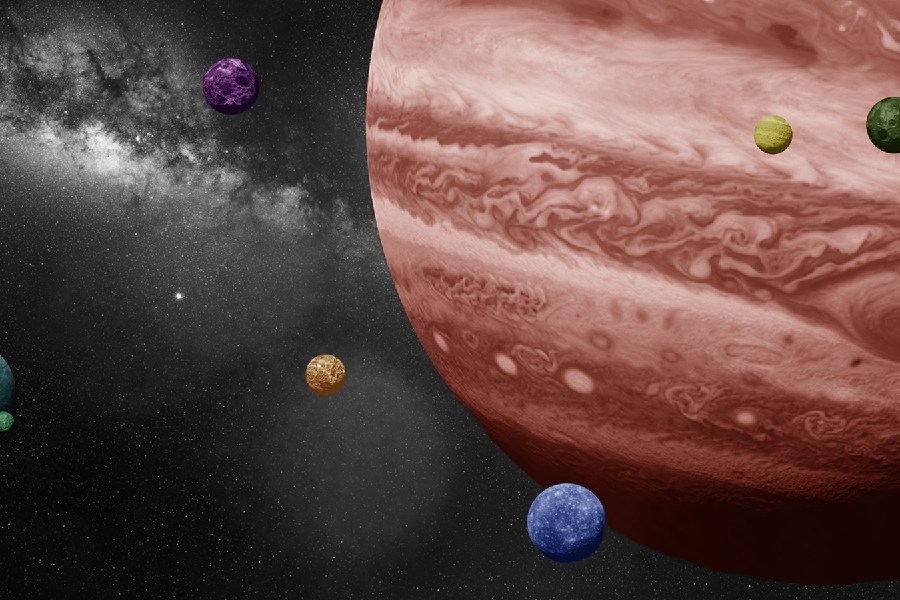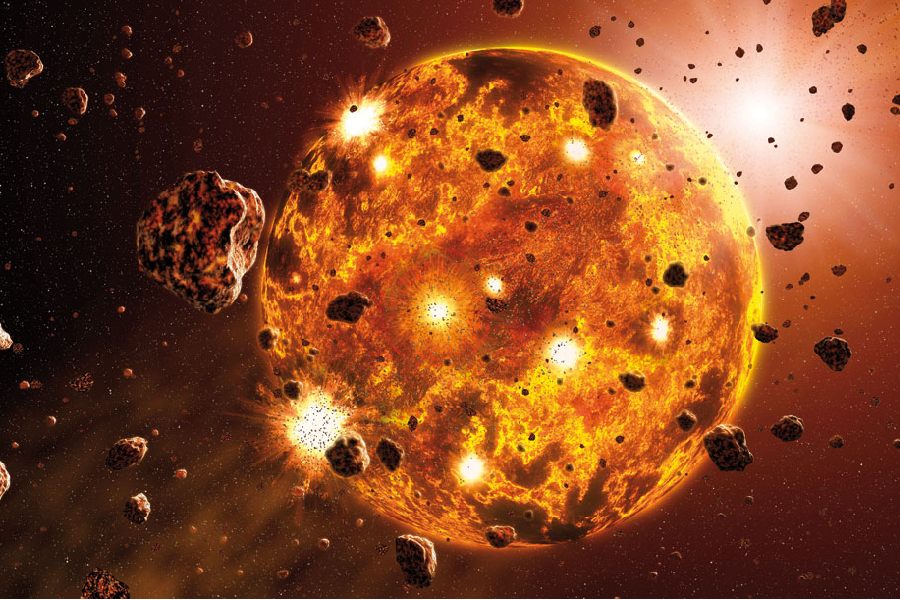Jupiter is known for its vibrant stripes, swirling storms, and impressive collection of moons. With over 92 confirmed moons, Jupiter boasts a moon system so extensive and diverse that it resembles a miniature Solar System. But how did Jupiter get its moons?
In this article, we’ll explore the various processes and events that contributed to the formation and acquisition of Jupiter’s moons. From the accretion of material during the early stages of the Solar System to the gravitational capture of wandering celestial bodies, we’ll discuss the scientific theories and evidence.
We’ll also dive into the unique characteristics of Jupiter’s four largest moons – Io, Europa, Ganymede, and Callisto – known as the Galilean moons. So, join us as we unravel the mysterious origins of Jupiter’s diverse lunar family!

How Did Jupiter Get Its Moons?
Jupiter likely got its moons through accretion, a process where gas and dust in the early Solar System came together. They gathered around Jupiter because of its strong gravity. Some of Jupiter’s big moons, like Io, Europa, Ganymede, and Callisto, are thought to have formed from a disk of material around Jupiter, much like how planets form around a star.
These moons likely went through a process of accretion and migration to their current positions around Jupiter. Jupiter’s gravity may have captured other smaller moons as they wandered through the Solar System.
So, how did Jupiter get so many moons? The specific details of each moon’s origin can vary, but the overall process involves the gravitational influence of Jupiter, shaping the formation and positioning of its moons.
Formation Theories
For centuries, astronomers have puzzled over how Jupiter acquired its diverse moons. Scientists have proposed various formation theories to explain the origin and evolution of Jupiter’s lunar system, considering the unique characteristics of the moons and the broader context of the Solar System’s formation.
By examining evidence and applying scientific principles, researchers have developed a clearer picture of the processes that likely shaped Jupiter’s moon system. However, these theories constantly evolve as new data and insights emerge.
As we explore the formation theories, we’ll investigate the strengths and limitations of each explanation and their contribution to understanding Jupiter’s moons. Here are the theories:
The Nebular hypothesis
The Nebular hypothesis is a well-accepted theory that explains how the Solar System, including planets and moons, formed. It suggests that everything started from a big swirling cloud of gas and dust known as the solar nebula.
As time passed, this cloud collapsed inward due to its own gravity, shaping a central protostar, which eventually became our Sun. Around this protostar, a flat disk of material formed. Within this disk, planets and moons gradually emerged from the leftover material.
The role of the primordial solar nebula
The primordial solar nebula played a crucial role in the formation of Jupiter and its moons. As the largest planet in our Solar System, Jupiter likely formed relatively early in the nebula’s history.
Its immense gravity allowed it to accrete a significant amount of gas and dust from the surrounding disk, growing to its current size. As Jupiter grew, its gravitational influence on the surrounding material became more pronounced, potentially influencing the formation of other planets and their moons.
Linking the Nebular hypothesis to Jupiter’s moon formation
The Nebular hypothesis offers a framework for understanding how Jupiter’s moons may have formed. As Jupiter grew and accreted material from the surrounding solar nebula, it is likely that some of this material also merged to form its moons.
One scenario suggests that the Galilean moons formed from the material in Jupiter’s circumplanetary disk. This disk was a smaller gas and dust accumulation surrounding the growing planet.
Another possibility is that some of Jupiter’s moons, particularly the irregular ones, may have formed elsewhere in the Solar System. These moons, with their more distant and inclined orbits, were later captured by Jupiter’s gravity.
Capture theory
Capture theory is an alternative hypothesis that explains the origin of some of Jupiter’s moons. This theory suggests that certain moons, particularly the irregular ones, may not have formed in situ around Jupiter. Instead, the planet’s gravitational field captured these moons with their distant and inclined orbits.
The captured moons are thought to have originated elsewhere in the Solar System, possibly as independent objects or as part of other celestial bodies. At some point during Jupiter’s early history, these objects ventured too close to the giant planet. They were gravitationally captured, becoming part of its lunar system.
Exploring the possibility of external capture
The idea of external capture is supported by the unique characteristics of Jupiter’s irregular moons. These moons have orbits that are highly inclined and eccentric compared to the regular, prograde orbits of the Galilean moons.
This suggests that the irregular moons have a different origin story. They likely formed in other regions of the Solar System and were later captured by Jupiter’s gravity. The capture process could have occurred through various mechanisms, such as gravitational interactions, collisions, or dissipative forces like gas drag.
Evaluating Jupiter’s gravitational influence
Jupiter’s immense gravitational influence plays a crucial role in the capture theory. As the most massive planet in our Solar System, Jupiter has a strong gravitational field that extends far beyond its immediate vicinity.
This extensive gravitational reach allows Jupiter to interact with and potentially capture objects that come within its sphere of influence. The planet’s gravity can alter the trajectories of passing objects, slowing them down and leading to their eventual capture.
However, the exact details of how and when these captures occurred remain uncertain. Factors such as Jupiter’s migration through the early Solar System, the presence of a dense gaseous envelope around the planet, and the interactions with other celestial bodies may have contributed to the capture process.

Core accretion theory
Core accretion theory is another prominent hypothesis that explains the formation of Jupiter’s moons. This theory suggests that the moons formed gradually through the accumulation of smaller particles and debris around the giant planet. So, how did Jupiter get its moons?
According to this theory, as Jupiter formed and grew in the early Solar System, it was surrounded by a disk of gas and dust. Within this disk, small particles began to collide and stick together, forming large clumps of material.
Gradual accumulation of material
As the accretion process continued, these clumps grew in size, eventually forming moonlets. The moonlets then continued to attract more material through gravitational interactions, gradually increasing in mass and size.
Over time, the most massive moonlets became the dominant bodies in their orbital regions, absorbing or scattering smaller objects. This process of accretion and growth eventually led to the formation of the moons we observe today.
Formation through orbital processes
The core accretion theory also takes into account the role of orbital processes in shaping the moon system. As the moons formed and grew, their orbits were influenced by gravitational interactions with Jupiter and other moons.
These interactions could have led to orbital resonances, where the orbital periods of the moons are related by simple integer ratios. The Galilean moons, for example, exhibit a 1:2:4 orbital resonance, which suggests a common formation process.
Furthermore, the accretion process could have been affected by Jupiter’s migration within the Solar System. As the planet moved inward or outward, its gravitational influence on the surrounding material would have changed. This could have potentially impacted the formation and evolution of its moons.
Collisions and fragmentation
Collisions and fragmentation have played a significant role in shaping Jupiter’s moon system. Throughout the history of the Solar System, Jupiter and its moons have been subjected to numerous impacts from comets, asteroids, and other celestial objects.
These collisions have had various consequences for the moons, ranging from surface modifications to more drastic changes. In some cases, collisions may have led to the fragmentation of larger moons, creating smaller moonlets or debris fields.
Role of comets, asteroids, and other objects
Comets, asteroids, and other small celestial bodies have been key players in the collisional history of Jupiter’s moons. These objects, which are remnants from the early Solar System, can be gravitationally perturbed by Jupiter’s massive presence.
As a result, some of these objects may be deflected into the vicinity of Jupiter’s moons, leading to potential collisions. The impact of these collisions depends on factors such as the size, speed, and composition of the colliding bodies.
Contributions to the diversity of Jupiter’s moon system
Collisions and fragmentation have contributed to the diversity of Jupiter’s moon system in several ways. Impacts can resurface moons, creating new geological features and altering their surface compositions.
Fragmentation events can lead to the creation of smaller moons or debris rings, adding to the complexity of the system. Moreover, collisions can potentially bring in new material from outside the Jovian system, introducing additional compositional variety.
The effects of collisions and fragmentation are not uniform across all of Jupiter’s moons. The larger and more massive moons, such as the Galilean moons, are more likely to retain the scars of past impacts. On the other hand, smaller moons may have experienced more drastic changes or even complete disruption.
Conclusion
How did Jupiter get its moons? Jupiter’s moons offer a captivating glimpse into the intricate workings of our solar system’s formation and evolution. With over 92 confirmed moons, Jupiter’s diverse lunar family resembles a miniature solar system in itself.
Scientific theories such as the Nebular hypothesis, capture theory, and core accretion theory provide valuable insights into the processes that contributed to the formation of these moons. Additionally, collisions and fragmentation have played a significant role in shaping Jupiter’s moon system, adding to its complexity and diversity.
Through simulations and observations, scientists continue to unravel the mysteries surrounding Jupiter’s moons, deepening our understanding of the dynamic forces at play in our celestial neighborhood. As they explore further, Jupiter’s moons stand as remarkable testaments to the cosmic dance of gravitational forces.
